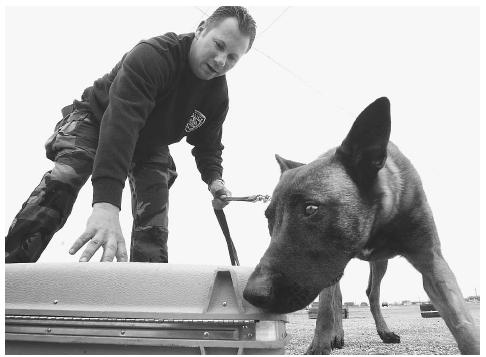Bomb makers are getting craftier and only ONE creature can save the day…dogs!
The Transportation Safety Administration has been training dogs to sniff out bombs and drugs for decades. Dogs, with their keen sense of smell, have been able to be trained to save lives.

To train these canine heroes, the TSA holds training in an elite facility meant for only the best and bravest dogs. The Lackland Air Force Base holds the location where 230 dog hopefuls are training with the goal of becoming key public safety officials. After graduation, these pooches will be sent to airports nationwide to inspect and protect.
In recent years, terrorists and run of the mill criminals have invented new ways to infiltrate America’s security systems. Certain chemicals are being used by bomb makers to trick bomb sniffing dogs. Studies are currently underway to figure out a way that humans can better train dogs to sniff out for bombs.
New Ways to Handle an Old Problem
It has been well-known for years that dogs have an amazing sense of smell. Hounds have been used for hunting foxes, geese, and even sniffing out a lost sheep among the herd. In fact, dogs have 1,000 times better hearing than humans do as reported by the Alabama Cooperative Extension System (ACES).

Dogs’ noses are proven to be effective, but why is that? The ACES published a brief report on the science behind dogs’ noses. In essence, the way in which a dog’s nasal cavity is structured makes it perfect for scent detection. Plus, dogs have a reported 220 million olfactory sensors whereas humans only carry about 5 million.
The power of a dog’s nose has not gone unnoticed by the U.S. federal government. Since the 9/11 attacks, scientists and engineers have spent a considerable fortune trying to artificially recreate a dog’s nose. The idea was to mass produce machines to detect scents. Due to the amazingness of these doggies, researchers have not come close.
As wonderful as that sounds for dogs, humans are trying to outsmart them regularly. That means new training programs.
New Technologies are Challenging the Power of a Dog’s Nose
The need for new training comes as result of new technology. A favorite household chemical of bomb makers is called TATP. The compound is easily attainable to make explosives. Plus, the explosives are being sealed off using caulk. The caulk traps the scents inside, making it harder for dogs to detect.

To combat this, trainers are making sure to train the dogs to smell components that can make a bomb. This is on top of their previous training programs to detect bombs, drugs, and anything else that may come across their noses.
The supervisor of canine training of the facility, Danny Diller, elaborates that there are over 240 powder substances alone that don’t produce vapors. Meaning, that training a canine to detect everything is challenging if not impossible.
It’s not just substances that are changing. Longer security lines following heightened security measures means that travelers are now in danger prior to ever getting on the plane. This means more dogs trained to deal with big crowds and big problems.
Looking for a Few Good Dogs
Not just any dog can make it to the big leagues of bomb sniffing. The dogs are selected from Europe through a government funded program. These elite doggies are trained from the time of 1 1/2 to 2 years old.
Training for certain young pups involve a fifteen week course on bomb detection and proper social behaviors in big crowds. For the next level trainees, the dogs are trained for twenty-five weeks to be able to sniff actual passengers to smell dangerous chemicals.

Not just any dog is good enough for service. Evidently, certain breeds are destined for this job. The best breeds are Labradors, German Pointers, German Shepherds, and Belgian Malinoises. For the Dachshunds or Pugs of the world, they will have to find their patriotic purpose elsewhere.
Still, there are major problems with relying on bomb sniffing dogs. Besides the number of substances available on the market, a dog’s nose is not foolproof. Studies on drug sniffing dogs in recent yeats have led to questions about their use in court proceedings. Even the trainers at the facility cannot guarantee that every dog will be able to detect bombs.
There is hope, however. With increased trainings and research, the TSA hopes to increase the effectiveness of the bombing sniffing dog squad. Even though terrorists are getting smarter, they are no match for a dog’s nose.
[adinserter block=”7″]
[adinserter block=”2″]
